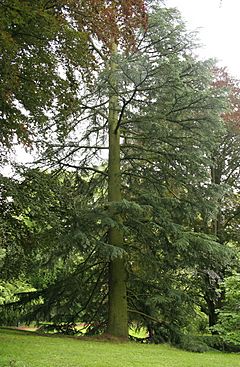Deodar cedar facts for kids
Quick facts for kids Deodar Cedar |
|
|---|---|
 |
|
| A young tree in cultivation | |
| Scientific classification | |
| Kingdom: | |
| Division: | |
| Class: | |
| Order: | |
| Family: | |
| Genus: | |
| Species: |
C. deodara
|
| Binomial name | |
| Cedrus deodara (Roxb.) G.Don
|
|
The Deodar Cedar (Cedrus deodara) is a beautiful and tall tree. It is also known as the Himalayan Cedar. You can find these trees growing in the western Himalayas. They also live in eastern Afghanistan, northern Pakistan, and parts of India and Nepal. These cedars like to grow in mountains, usually at heights of 1500 to 3200 meters above sea level.
The Deodar Cedar is an evergreen tree. This means its leaves stay green all year round. It can grow very tall, often reaching 40 to 50 meters (about 130 to 160 feet). Some even grow as tall as 60 meters! Their trunks can be up to 3 meters (10 feet) thick. These trees have a special cone shape. Their branches spread out flat, and the smaller branches hang down.
The leaves of the Deodar Cedar are like needles. They are usually 2.5 to 5 centimeters long, but can be up to 7 centimeters. They are very thin, about 1 millimeter thick. The leaves grow in two ways: some grow alone on long shoots, and others grow in tight groups of 20 to 30 on short shoots. Their color can be bright green or a cool blue-green.
The female cones are shaped like barrels. They are 7 to 13 centimeters long and 5 to 9 centimeters wide. When they are ready, after about a year, they break apart. This releases their winged seeds. The male cones are smaller, about 4 to 6 centimeters long. They release their pollen in the autumn.
Contents
Growing Deodar Cedars
Deodar Cedars are popular ornamental trees. People often plant them in parks and large gardens. They are loved for their graceful, drooping branches. These trees grow best in places with mild winters. They usually cannot survive if temperatures drop below about -25 degrees Celsius (-13 degrees Fahrenheit). This means they thrive in warmer areas.
Some Deodar Cedars are more resistant to cold. These come from the northwest parts of their natural home. This includes areas like Kashmir and Paktia Province in Afghanistan. Special types of these trees can handle temperatures down to about -30 degrees Celsius (-22 degrees Fahrenheit). Some of these special types have names like 'Kashmir' and 'Shalimar'.
The Deodar Cedar has won an important award. It received the Royal Horticultural Society's Award of Garden Merit. This award means it is an excellent plant for gardens.
Building with Deodar Wood
Deodar wood is very popular for building. This is because it is strong and lasts a long time. It does not rot easily. The wood also has a fine, tight grain. This means it can be polished to look very smooth and shiny.
Historically, people used Deodar wood to build religious temples. They also used it for landscaping around these temples. Because it resists rot, it is perfect for building the famous houseboats in Srinagar, Kashmir. During the time of British rule in Pakistan and India, Deodar wood was used a lot. It helped build army barracks, public buildings, bridges, and even railway cars.
Even though it lasts a long time, Deodar wood is not super strong. It can be a bit brittle. This makes it less suitable for delicate items that need a lot of strength, like chairs.
Traditional Uses and Benefits
The Deodar Cedar has been used in Ayurveda, a traditional Indian medicine system. The inner wood of the tree has a nice smell. People use it to make incense. This inner wood can also be distilled to make an essential oil.
Insects do not like this tree. Because of this, the essential oil is used as an insect repellent. People put it on the feet of horses, cattle, and camels. The oil also helps stop fungus from growing. This means it can help keep spices fresh during storage. The outer bark and stem of the tree can also be used in traditional remedies.
Because of its special properties, rooms made of Deodar wood are used to store food. People in areas like Shimla and Kullu in Himachal Pradesh store meat and grains like oats and wheat in these rooms. In Himachal Pradesh, some people believe sitting under a Deodar tree early in the morning can help with breathing problems like asthma.
Cedar oil is also used in aromatherapy because of its woody smell. The raw oil is often yellowish or darker. It is used in many products. These include soap perfumes, household sprays, and floor polishes. It is also used as an insecticide. Scientists even use it in microscopes as a special oil.
Images for kids
See also
 In Spanish: Cedro del Himalaya para niños
In Spanish: Cedro del Himalaya para niños




